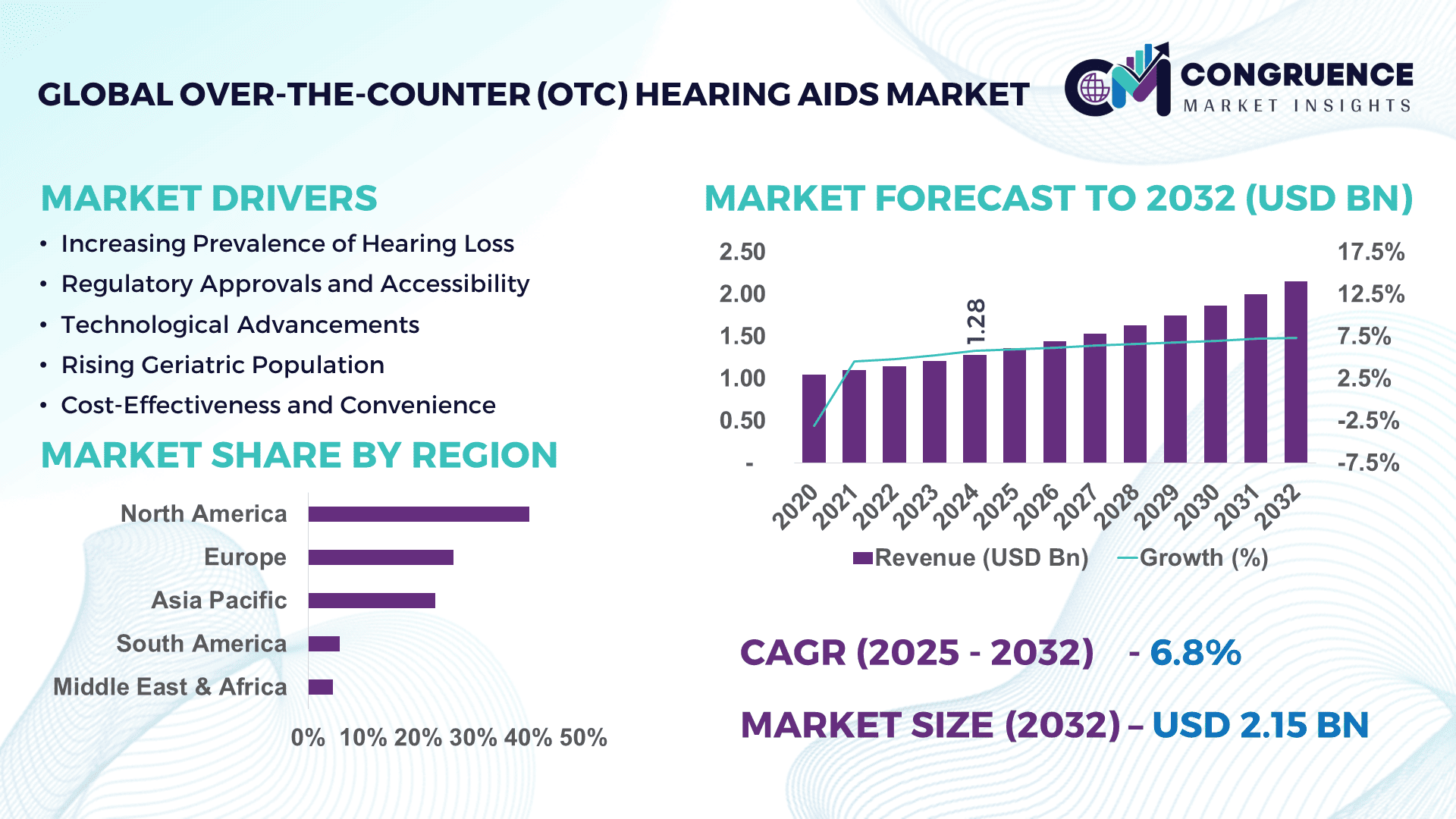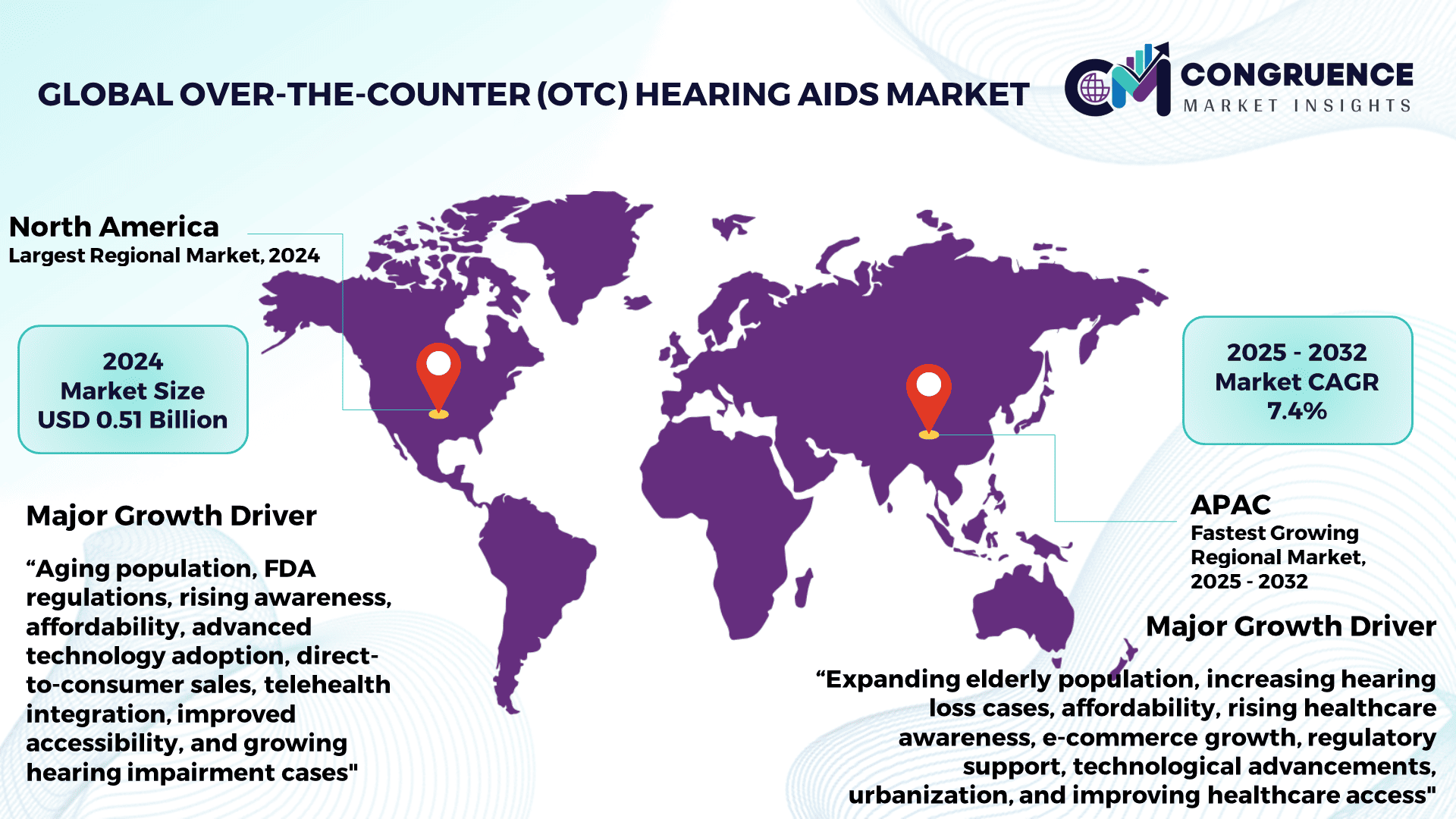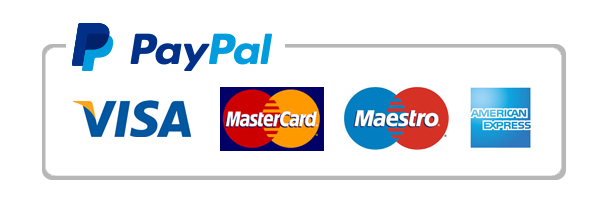Reports
Over-the-Counter (OTC) Hearing Aids Market Report Overview
The Global Over-the-Counter (OTC) Hearing Aids Market was valued at USD 1.28 Billion in 2024 and is anticipated to reach a value of USD 2.15 Billion by 2032 expanding at a CAGR of 6.8% between 2025 and 2032. The over-the-counter (OTC) hearing aids market is being pushed by rising occurrences of hearing loss, an aging population, and increased awareness of hearing health. The FDA's approval of over-the-counter hearing aids has transformed accessibility, making hearing treatments more cheap while eliminating the requirement for physician prescriptions.

To Learn More About This Report, Request A Free Sample Copy
The Over-the-Counter (OTC) Hearing Aids Market is expanding rapidly due to the rising prevalence of age-related and noise-induced hearing loss. According to the World Health Organization (WHO), over 1.5 billion people worldwide suffer from hearing loss, which is anticipated to increase due to aging populations and prolonged exposure to noisy surroundings. OTC hearing devices are a more inexpensive, accessible, and handy alternative to traditional hearing aids, eliminating the need for audiologist prescriptions and lowering obstacles to treatment. Advances in downsizing, Bluetooth connectivity, and AI-driven sound processing are increasing product appeal, particularly among younger consumers and tech-savvy customers. The high prevalence of noise-induced hearing loss (NIHL) and the increasing acceptance of digital hearing solutions are driving up demand. The market is also benefiting from e-commerce expansion, which allows consumers to purchase products more easily. However, problems such as a lack of expert assistance for OTC devices and consumer worries about their performance continue to be significant impediments to market growth.
The FDA's approval of OTC hearing aids has revolutionized the business by allowing people to buy devices without a professional diagnosis, resulting in higher adoption rates. The market is also benefiting from technology improvements like smart hearing aids with AI-powered noise filtration and Bluetooth connectivity. Furthermore, the growing acceptability of self-managed healthcare solutions is driving customer choice for direct-to-consumer hearing aids, hence expanding the global market.
How AI is Transforming Over-the-Counter (OTC) Hearing Aids Market
Artificial intelligence (AI) is transforming the OTC hearing aids market by boosting sound quality, personalizing hearing experiences, and increasing accessibility. AI-powered hearing aids employ machine learning algorithms to automatically change loudness, filter out background noise, and improve speech recognition in real time. These smart capabilities eliminate user interaction and provide a more natural listening experience, especially in noisy settings such as busy streets or social gatherings. AI-powered voice recognition and language processing features enhance hearing aid functionality by allowing users to adjust settings based on surrounding sounds. Some models use cloud-based AI algorithms to learn user preferences over time and adjust based on previous listening habits.
Additionally, AI is playing an important role in hearing health monitoring. Advanced OTC hearing aids now include real-time diagnostics, which alert users to probable hearing loss and recommend changes. AI is also enabling hearing aids to interface with smartphones and smart home devices, resulting in a unified digital ecosystem. In the future, AI-driven natural language processing and voice assistants will improve user experiences, making over-the-counter hearing aids more intuitive, effective, and personalized. As AI capabilities increase, they will close the gap between over-the-counter and professionally fitted hearing aids, boosting customer confidence in self-managed hearing solutions.
Over-the-Counter (OTC) Hearing Aids Market Major Driving Forces
· Increasing Prevalence of Hearing Loss: The global increase in hearing impairments, notably age-related hearing loss (presbycusis) and noise-induced hearing loss (NIHL), is fueling demand for over-the-counter hearing aids. Over 2.5 billion individuals are expected to experience hearing loss by 2050, according to the World Health Organization.
· Regulatory Approvals and Accessibility: The FDA's clearance of over-the-counter hearing aids has decreased barriers to hearing solutions, allowing consumers to purchase them directly without a medical consultation.
· Technological Advancements: Technological advancements include AI, Bluetooth connectivity, rechargeable batteries, and noise cancellation technologies, which make OTC hearing aids more effective and user friendly.
· Rising Geriatric Population: As the world's geriatric population grows, so does the need for hearing aids, particularly among people over 65, who are more likely to have hearing loss.
· Cost-Effectiveness and Convenience: Compared to traditional hearing aids, which frequently require expensive professional fits, OTC hearing aids are a more affordable option.
Over-the-Counter (OTC) Hearing Aids Market Key Opportunities
· Growth in E-Commerce and Direct-to-Consumer Sales: The growth of online shopping platforms is opening up new options for OTC hearing aid makers to reach a larger audience.
· AI-Driven Personalization: Combining AI-powered noise filtration, voice recognition, and adaptive learning offers enormous growth potential for novel OTC hearing aids.
· Untapped Markets in Emerging Economies: Rising disposable incomes and improved healthcare awareness create huge prospects in Asia Pacific and Latin America.
· Collaboration with Insurance Providers: Working with insurance providers to provide reimbursement schemes for over-the-counter hearing aids can boost affordability and uptake.
Over-the-Counter (OTC) Hearing Aids Market Key Trends
· There is a rising demand for digital over-the-counter hearing aids. Consumers prefer digital ones with sophisticated features like Bluetooth connectivity and smartphone integration.
· Sustainability & eco-friendly designs represent another major trend in the over-the-counter (OTC) hearing aids market. Hearing aid manufacturers are increasingly using rechargeable batteries and biodegradable materials.
· Companies are using hybrid business models, mixing internet sales with in-store trials to provide a more personalized purchasing experience.
Region-wise Market Insights
North America accounted for the largest market share at 40.2% in 2024 however, Asia Pacific is expected to register the fastest growth, expanding at a CAGR of 7.4% between 2025 and 2032.

To Learn More About This Report, Request A Free Sample Copy
In 2024, North America dominated the Global Over-the-Counter (OTC) Hearing Aids Market. This dominance is fueled by widespread awareness, a well-established regulatory framework, and a strong presence of significant market actors. The United States is the top country due to expanding self-managed hearing solutions, an older population, and increased use of modern hearing aids.
· In March 2025, Eargo and hearX completed their merger and announced the formation of a new combined company, LXE Hearing. This strategic move aims to expand access to innovative hearing solutions and strengthen their position in the hearing technology market.
Asia Pacific is predicted to be the fastest-growing area, with a 7.4% CAGR from 2025 to 2032. Countries such as China, Japan, and India are experiencing significant demand as their senior populations grow, healthcare access expands, and disposable incomes rise. The introduction of digital and smart hearing aids is driving growth in this region.
Europe is another important market, fueled by government reimbursement rules and a well-established retail pharmacy network. Germany, France, and the United Kingdom are among the countries with the highest rates of OTC hearing aid adoption.
South America, the Middle East, and Africa are emerging markets, but they are likely to grow steadily due to increased awareness, urbanization, and improved distribution methods. Expanding online shopping and telemedicine options are assisting in overcoming traditional accessibility barriers in these areas.
Recent Developments
· In August 2024, Sony and WS Audiology introduced a new over-the-counter (OTC) hearing aid, expanding access to affordable, high-quality hearing solutions. The device leverages Sony’s consumer technology expertise and WSA’s audiology experience, offering users a discreet, self-fitting option for mild to moderate hearing loss.
· In February 2024, Oticon launched Oticon Intent, a hearing aid designed to enhance speech clarity using advanced AI-powered sound processing. This innovation aims to improve user experience by adapting to different listening environments. The technology marks a step forward in personalized hearing solutions.
· In October 2023, Audien Hearing launched the world’s first over-the-counter hearing aid priced under $100, available exclusively at Walmart. The device aimed to make hearing solutions more affordable and accessible to consumers with mild to moderate hearing loss.
· In August 2023, Audicus announced a new hearing aid line along with a subscription-based upgrade program. This initiative allows users to access the latest hearing technology through a monthly plan, ensuring continuous improvements without large upfront costs.
· In July 2022, Bose partnered with Lexie Hearing to expand access to affordable hearing aids. This collaboration integrated Bose’s self-tuning hearing technology with Lexie’s direct-to-consumer model, offering users an accessible, high-quality solution for mild to moderate hearing loss.
Market Competition Landscape
The global over-the-counter (OTC) hearing aids market is very competitive, with top competitors prioritizing technological improvements, strategic collaborations, and product innovations. To achieve a competitive advantage, companies are investing in AI-powered hearing aid solutions, boosting sound processing capabilities, and increasing battery economy. Sennheiser, WS Audiology, and Demant are the market's leading players, owing to their high brand awareness, R&D spending, and substantial distribution networks. These firms are constantly developing new digital hearing aids with Bluetooth connectivity and AI-powered sound modifications to meet changing consumer demands. In addition to established industry players, new entrants and startups offering affordable and bespoke hearing aid solutions are driving market rivalry. Companies are increasingly increasing direct-to-consumer (DTC) sales through internet channels to improve accessibility and affordability. Mergers, acquisitions, and alliances with telehealth providers and pharmacies are becoming popular tactics for increasing market penetration. Furthermore, sustainability trends are driving companies to create environmentally friendly and rechargeable hearing aids.
The competitive landscape is projected to alter further as regulatory clearances spread across regions, allowing new players to enter the market. Firms that prioritize innovation, affordability, and accessibility will sustain dominant market positions.
Key players in the global over-the-counter (OTC) hearing aids market implement various organic and inorganic strategies to strengthen and improve their market positioning. Prominent players in the market include:
· LXE Hearing
· Demant
· Sony Corporation
· Bose Corporation
· Audien Hearing
· Audicus
· Apple Inc.
· Phonak (Sonova Group)
· Jabra (GN Group)
· Starkey Hearing Technologies
· Sennheiser Hearing
· Lucid Hearing
· Intricon Corporation
· WS Audiology A/S
· Nuheara Limited
· Sound World Solutions
· GN Hearing A/S (ReSound)
|
Report Attribute/Metric |
Details |
|
Market Revenue in 2024 |
USD 1.28 Billion |
|
Market Revenue in 2032 |
USD 2.15 Billion |
|
CAGR (2025 – 2032) |
6.8% |
|
Base Year |
2024 |
|
Forecast Period |
2025 – 2032 |
|
Historical Data |
2020 to 2024 |
|
Forecast Unit |
Value (US$ Bn) |
|
Key Report Deliverable |
Revenue Forecast, Growth Trends, Market Dynamics, Segmental Overview, Regional and Country-wise Analysis, Competition Landscape |
|
Segments Covered |
· By Type (Self-fitting OTC Hearing Aids, Preset-based OTC Hearing Aids, and Hearing Aid Software) · By Fitting Type (In-the-Ear (ITE), Behind-the-Ear (BTE), Receiver-in-Canal (RIC), Completely-in-Canal (CIC), and Invisible-in-Canal (IIC)) · By Technology (Analog and Digital) · By Distribution Channel (Online Retailers, Pharmacies & Drug Stores, Hearing Aid Specialty Stores, and Supermarkets/Hypermarkets) · By End-User (Adults (18–59 years) and Geriatric Population (60+ years)) |
|
Geographies Covered |
North America: U.S., Canada and Mexico Europe: Germany, France, U.K., Italy, Spain, and Rest of Europe Asia Pacific: China, India, Japan, South Korea, Southeast Asia, and Rest of Asia Pacific South America: Brazil, Argentina, and Rest of Latin America Middle East & Africa: GCC Countries, South Africa, and Rest of Middle East & Africa |
|
Key Players Analyzed |
LXE Hearing, Demant, Sony Corporation, Bose Corporation, Audien Hearing, Audicus, Apple Inc., Phonak (Sonova Group), Jabra (GN Group), Starkey Hearing Technologies, Sennheiser Hearing, Lucid Hearing, Intricon Corporation, WS Audiology A/S, Nuheara Limited, Sound World Solutions, GN Hearing A/S (ReSound) |
|
Customization & Pricing |
Available on Request (10% Customization is Free) |
